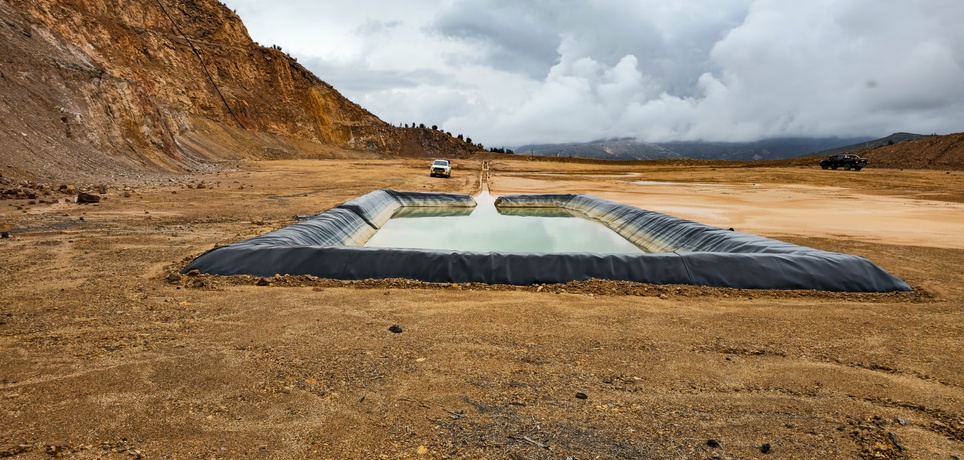A small drip can quickly become a major environmental and financial problem. When containment systems fail, the consequences extend beyond your immediate operations. Understanding how to respond when issues arise protects your investment and maintains compliance with environmental regulations.
Containment systems serve critical functions across industries, from agricultural operations to industrial facilities. These protective barriers prevent contamination of the surrounding soil and groundwater while maintaining the integrity of stored materials. When these systems fail, immediate action becomes necessary to avoid costly damage and regulatory violations.
The following guide provides step-by-step instructions for identifying, addressing, and preventing failures in containment systems. Quick recognition and proper response minimize damage and reduce long-term costs. Here’s what to do when a pit liner starts leaking.
Recognizing When Your Containment System Has Failed
Early detection prevents minor issues from becoming major disasters. Several warning signs indicate compromised containment integrity.
Dropping Water Levels
Water levels dropping without explanation often signal the first signs of trouble. Monitor liquid levels regularly and document any unexplained decreases. Even small changes over time can indicate developing problems that require immediate attention.
Unusual Odors
Unusual odors around the containment area suggest material has escaped the primary containment. Chemical vapors or the decomposition of organic matter produce distinct smells that become noticeable when materials migrate outside their designated area.
Staining or Discoloration
Visible staining or discoloration of the surrounding soil indicates material has breached the containment barrier. Look for color changes, unusual vegetation growth patterns, or dead vegetation near the containment structure. These visual cues often appear before other detection methods identify problems.
Groundwater Quality Changes
Changes in groundwater quality near the facility provide another detection method. Regular testing of monitoring wells identifies contamination before it spreads to larger areas. Increased conductivity, pH changes, or the presence of specific chemicals indicate containment failure.
Structural Damage
Structural damage to the containment system creates obvious leak points. Inspect all visible surfaces for tears, punctures, or separation at seams. Physical damage often occurs gradually and may not produce immediate visible leaks.

Understanding Common Failure Causes
Physical damage represents the most common cause of containment system failures. Heavy machinery, sharp objects, or excessive loading can puncture or tear protective barriers. Construction activities, maintenance operations, and normal wear create vulnerability points that develop into leaks over time.
Chemical degradation occurs when incompatible materials come into contact with the containment system. Strong acids, bases, or organic solvents can break down protective materials, creating weak spots that eventually lead to failure. Different materials show varying resistance to specific chemicals, making compatibility assessment critical during system design.
Installation errors can create long-term problems that may not become apparent immediately. Poor seam welding, inadequate substrate preparation, or incorrect material selection lead to premature failures. These issues often manifest months or years after installation, making identification difficult without proper documentation.
Natural aging affects all materials over time. UV exposure, temperature cycling, and oxidation gradually reduce material strength and flexibility. Pit liners exposed to harsh environmental conditions deteriorate faster than those in controlled environments.
Ground movement from settling, frost heave, or seismic activity can stress containment systems beyond design limits. Differential settlement creates tension points that concentrate stress and lead to failure.
Taking Immediate Action
Safety considerations take priority over all other concerns when discovering containment failures. Evacuate personnel from the immediate area if hazardous materials are involved. Assess atmospheric conditions and implement appropriate personal protective equipment requirements before beginning containment efforts.
Stop adding materials to the compromised containment system immediately. Continued loading increases the leak rate and spreads contamination over larger areas. Make sure to document current liquid levels and photograph damage for insurance and regulatory reporting purposes.
Contact regulatory authorities as required by local, state, and federal regulations. Many jurisdictions require immediate notification of containment failures, especially when groundwater or surface water contamination is possible. Failure to report violations can result in significant penalties, including those beyond cleanup costs.
Begin emergency containment procedures to limit the spread of contamination. Deploy absorbent materials, temporary barriers, or backup containment systems to capture escaped materials. Focus on protecting drainage systems, water supplies, and sensitive environmental areas.
Implement monitoring procedures to track contamination extent and migration patterns. Install temporary monitoring points if permanent systems are inadequate. Regular sampling provides data necessary for cleanup planning and regulatory compliance.

Implementing Short-Term Repairs
Temporary patching provides immediate relief while planning permanent repairs. Clean the damaged area thoroughly, removing all contaminants and loose material. Surface preparation significantly influences the quality and longevity of patch adhesion.
Select patch materials that are compatible with both the original containment system and the stored materials. Incompatible materials may fail quickly or create additional problems. Consult manufacturer specifications or technical experts when selecting repair materials.
Apply patches according to the manufacturer’s instructions, paying attention to the temperature and humidity requirements. Poor application conditions lead to patch failure and repeated repairs. Allow adequate curing time before returning the system to service.
Install temporary drainage systems to manage accumulated liquids during repair operations. Pumping systems, collection sumps, and transfer equipment prevent further contamination while repairs are in progress.
Monitor repair effectiveness through regular inspections and liquid level measurements. Make sure to document repair performance to guide future maintenance decisions and evaluate repair material effectiveness.
Planning Long-Term Solutions
Professional assessment determines whether repairs or replacement provides the most cost-effective solution. Experienced technicians can evaluate damage extent, remaining system life, and repair feasibility. This assessment guides investment decisions and prevents recurring problems.
Complete system replacement may prove more economical than extensive repairs, especially for older installations. New systems incorporate improved materials and installation techniques, providing better long-term performance. Consider upgrading to more durable materials or improved designs during replacement projects.
Professional installation eliminates many common failure causes associated with improper techniques. Certified installers understand material properties, seam requirements, and quality control procedures that extend system life. Documentation of professional installation supports warranty claims and regulatory compliance.
Develop emergency response procedures for future incidents. Having the necessary equipment, materials, and trained personnel available reduces response time and limits damage when problems arise. Regular training keeps personnel current on proper procedures and safety requirements.
Preventing Future Problems
Regular inspection programs identify developing problems before failures occur. Develop inspection checklists specific to your containment system type and stored materials. You should document inspection results and track changes over time to identify deterioration patterns.
Implement proper maintenance procedures to extend system life and prevent premature failures. Remove accumulated debris, repair minor damage promptly, and maintain proper drainage around containment structures. Proactive maintenance costs significantly less than emergency repairs and cleanup operations.
Verify chemical compatibility before storing new materials or changing operating procedures. Materials that appear similar may have different chemical properties that affect containment system integrity. Maintain accurate records of all materials stored and their compatibility with system components.
Train personnel on proper operating procedures and early warning signs of system problems. Well-trained operators identify issues early and avoid activities that damage containment systems. Regular training updates keep personnel current on best practices and regulatory requirements.
Protecting Your Investment Through Proper Response
A leaking pit liner requires an immediate, coordinated response to minimize damage and maintain regulatory compliance. Early detection, proper emergency procedures, and professional repairs protect both financial investments and environmental resources. Implementing comprehensive prevention programs reduces failure frequency and extends system life.
Professional assessment and repair services offer expertise that prevents recurring problems and maintains the long-term integrity of the system. Investing in quality repairs and preventive maintenance programs proves to be more cost-effective than responding repeatedly to containment failures.


